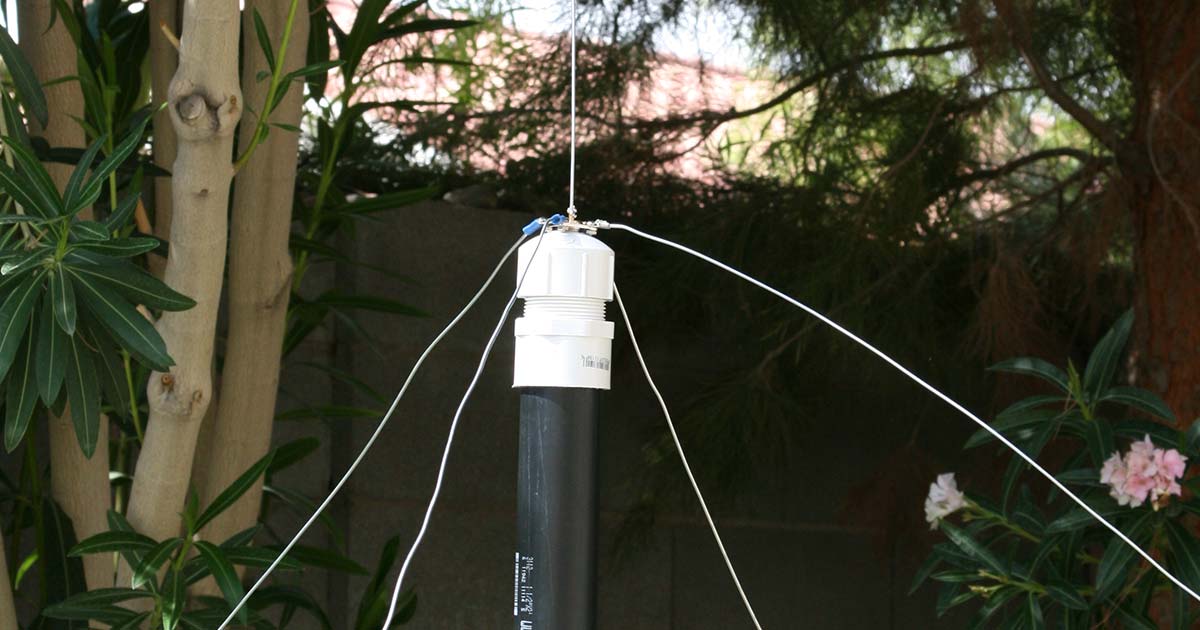
In the past we’ve talked about the many benefits of Ham Radio, and how every good survival plan should include some type of emergency communications equipment. When the power lines go down and cell phones stop working; the ability to send and receive information is going to be a critical factor in determining the outcome of your situation
In the coming month’s we are going to give some attention to the topic of emergency communication, and show you what it takes to communicate when the grid goes down.
Today, I’m going to show you how you can easily build a homebrew 2 Meter ¼ Wave vertical antenna for under $10. This antenna is perfect for HAMS that need a quick reliable solution for local 2 meter communication. It’s also a great antenna for emergency communication and can be fabricated and launched in a matter of minutes.
The ¼ Wave Droopy Ground Plane Antenna
ANTENNA PARTS LIST:
Keep in mind that this, and most HAM antennas, can be made with parts that you probably already have lying around your home. The parts below are what I used to build the antenna, but you can substitute most of these parts with whatever you have around your house.
- 1- 1 1/2″ PVC Pipe
- 2 – 1 1/2″ Adapter
- 1 -1 1/2″ Cap
- 1 -SO-239 Connector
- 50 ohm Coax
- Galvanized Utility Wire (16-14 Gauge) – Straightened and cut into 5 pieces (lengths below)
- 4 – 6-32 Stainless Machine Screws
- 4 – 6-32 Stainless Machine Hex Nuts
- 4 – #6 Crimp on Ring Tongue Terminals (16-14 Gauge)
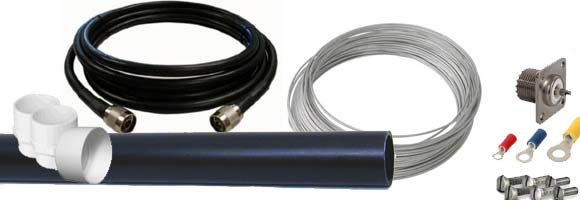
Assembling the Antenna
The first thing I did was to assemble the actual working part of the antenna. To do this I cut and straightened 5 pieces of the galvanized utility wire down to about 20 inches.

To figure out the length of your antenna’s vertical and radial elements, you can use the following formula:
Length (in.) = 2808 / F
F= 146 MHz.
I used the middle of the band which is 146MHz. This calculated out to about 19.25”, which is what I eventually cut the wire down to when I had everything assembled.
Attaching the Vertical Element and Radials
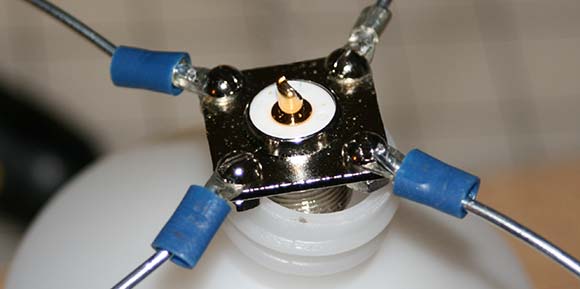
Take 4 pieces of wire, which will be used as the antenna’s radials, and attach them to SO239 mounting holes using the machine screws and the ring tongue terminals.
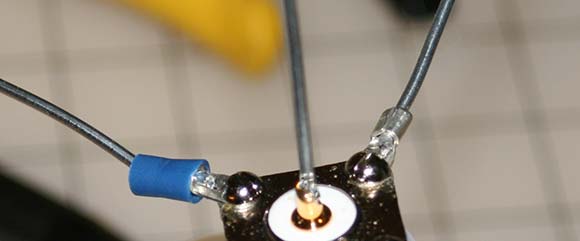
Next, solder the vertical element of antenna to the center connector of the SO239 connector. After you are done soldering and connecting the radials, your connector should look like the picture above.
Final Antenna Assembly:
PVC – The PVC is used to stabilize the antenna so you can attach it to a tree, a tripod stand or anything that gets it up off ground. If you don’t have PVC, you can use any non-conductive material to build the base.

Take the 1 1/2” adapters and glue them to your PVC pipe; one on the top and one on the bottom (the bottom adapter can be used to mount the antenna to a flange for stability). Next drill a 5/8 inch hole in the top of your 1 1/2” cap and then attach it to the top adapter.
Slide the coax through the PVC pipe and connect to your SO-239 connector.
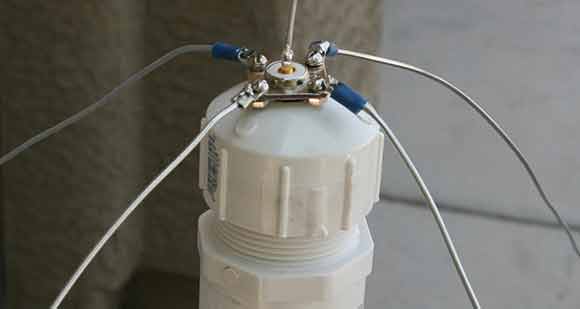
Bend your radials at a 45 degree angle; you now have a working antenna.

Antenna Performance

For under $10 worth of material, I was able to build a reliable antenna that can easily access all of the local repeaters with only 5 watts of power. At 25 watts, I was able to hit repeaters over 100 miles away
For more information on Ham Radio and Emergency Communication, check out these articles:
- Prepper Radio: The No-BS Ham Radio Technician Exam Prep Guide
Your Key to Passing the Amateur Radio Technician License Test and Taking Your Emergency Communication Skills to the Next Level - Emergency Communications When TSHTF
- Ham Radio Cheat Sheet
- Situational Intel: Knowledge is Power during a Crisis
- Ham Radio FAQs



Very cool idea, but a word of caution. The center element is in a fragile position in this design. Perhaps cutting some cross lines in the PVC and putting a strain relief on the coax which you thread through a hole in a cap would allow the center element to be protected inside the PVC. Just a suggestion from a amateur operator who’s broken a lot of things :)
For a standing base that would be good but what about driving
The way you have it is fine, just use 10-12 gauge wire and spin it in while clamped in a vice and chucked in a drill. It will create perfectly straight wire!
I use dual wall adhesive heat shrink to reinforce my center element as well.
What do u make of someone using this to stalk some one?
That was my first non rubber duck HAM antenna. It worked well for many years, until I replaced it with something better.
Can you get a close 1:1 SWR? And 2808inches, is that the full wavelength?
If you put a small loop on the end of the top element, this little baby will hang just about anywhere! Paint it flat black and it is very stealthy with no mast.
How about a blob of hot melt glue around that center element for strain relief? You could build it up and it is cheap and non-conductive.
Now this is what we need, great ideas like this is why I enjoy this site so much!
Keep them coming!
My wife complains about the “ugly” antennas in the back yard. Because I love antennas, I would reply “There is no such thing as an ugly antenna.” But, I take it back, that’s an ugly antenna!
maximum utilization of available resources….is the key to survivability…….
Thanks for the post. As a fellow amateur radio operator, I’m always on the lookout for new and creative antenna designs.
Joe
Good idea and easy. Also by cutting to the correct length, a 440 antenna can be made the same way. How about a yagi design?
the length for a half wave is just 2X’s as long?
or 38.5 inches?
Yes… 2 meters is, well…2 meters or roughly 78 inches. So half of that would be 39. Since we’re not using the “top” of the band when we build antennas, 38.5 inches should be just fine for the middle of the band. You could, if you wanted, buy a mobile whip for a 5/8’s wave and cut it down to 38.5 inches and solder that to the center… I think your radials would have to change size at that point, too, though.
when the power lines go down and the cell phones dont work 90 % of all ham radio will no longer work either. only that run on mobile simplex and handhelds will still work. thats pretty limited. so at that point the nice ham rig just turned into a real pricey item with the effective use of a 50 dollar cb radio.
Your statement is very uninformed and 90% is not true, most hams take pride in being able to run with their own means of power, i.e. batteries, generators etc. Every year hams participate in whats called “field day” to prove this point. Field day is an event that takes place world wide so hams can practice for emergencies. And if I were given the choice between a 4 watt CB or a 50 watt 2 meter simplex radio, I’ll choose the 2 meter ham radio every time. I do recommend that anyone interested should educate themselves about amateur radio, knowledge is power (and life).
True on the 2 meter being better. Funny thing though, I have a Pierce Simpson CB with 75 watts from the factory. Currently working on its restoration. It has vac tubes!
I agree with just looking. In my area the repeaters run off batteries powered by solar panels. In case of power outage, 2 meter communication is not limited to simplex.
I’m sorry but you’re misinformed. After Hurricane Andrew I operated for 3 weeks with the Salvation Army using a marine battery, charging it once a day with my truck and jumper cables. I was working mostly 2 meters (the subject of this antenna project) and easily passed simplex communications the majority of the time.
After Hurricane Charlie it was 5 weeks before phone service was restored to my mother’s house in Port Charlotte. I ran my HF radio the entire time on a marine battery, recharging it with a generator at night. We were able to chat with family in Texas, Nashville, and Boston on HF almost every day. Power was not restored to her house until 7 weeks after the hurricane. Between my truck, generator, and solar panels, I can keep batteries charged almost indefinitely, and with a few long wires I can talk almost worldwide on any given day.
Oh, and with a good antenna, I can still talk over most of Florida with my CB radio so don’t count out the “Children’s Band”.
A big part of emergency communications involves knowing how to use your equipment during an emergency. I would rephrase your comments to say that (well) over 90% of Amateur Radio operators can very easily communicate “Anytime, anywhere”.
73 de Paul, KC4YDY
NNNN
google A.R.E.S. and R.A.C.E.S. and C.E.R.T.
Most ham radio operators that are members of these groups have alternative ways to power their radios.
I.e. solar, backup batteries, generators, etcetc.
Theres a reason the ham radio motto is…..”When all else fails” There is still ham radio :)
Last extended power outage I had was 10 days when a major storm flooded us in without power. We live on a ridge so we were an island in effect.
It was a mere annoyance. Switched the mains over, fired up the generator and was back in business. Hams were the orginal preppers, we’ve been doing emergency communications in lights out disasters for decades. Chuck -WB8CEE
Nope. Most repeaters have back up power and who do you think did ALL the communications for hurricane Katrina? Hams.
In The 80s I Made A 1/2 Wave With Two Sections Of Copper Wire 109 Inches Long(The Size On Telephone Poles For Grounding Wire)with A Black Insulator Between The Sections,Solider The Ends Of The Coax The Center Lead To The Top Copper Wire The Ground To The Bottom Copper Section .Tied The Top End Of The Top Section To A Soft ball Size R rock With A Small Twine Throw It Over A Limb In A Pine Tree , Tied The Other End To A Rock With A Twine And Pulled The Slack Out It Was On About A 60 to 70 Degree Angle. It Worked Great. Al Miley
I have a Dia 45 in dish can i use this as a ground and use a copper pipe in the middle will it work. I am not a Ham yet studing for it. If any body could get back to me let me know if this is going to work thks Nupe 73
is there any gain for this type of antenna?
I’ve first received this link from my elmer who googled it for me a little over a year ago…I have yet to still make it, but I have one question: if I want to hang this from the side of my house, would a loop at the top of the antenna and an eye hook work? Or what materials would I need to use for hanging next to the house?
Thanks, and 73 to all…
Jonathan Marshall, KD0SVK
A J-pole will beat this hands down. And can be built for less than $5…..depending on your junk pile of parts.
I built a J-pole antenna & I could never get the swr’s lower than 2, idk what I was doing wrong
Hawkeyes, try one. Make it without the PVC. Dirt cheap, way less expensive than copper tubing and doesn’t have feedline radiation like a J-pole.
I like the idea behind this.
I think a way to disconnect all the wires, including the center whip would be good. The ability to shove all the wires into the pipe for storage would be useful.
So how can this adapt to the top of a fiberglass motorhome? Do the ground radials have to be bent at 45 degrees? Need to keep my height down. Would be nice to have an antenna no more than 25″ and have the radials strapped down to the roof somehow. Anybody got ideas that will work in this case?
To use temporarily on the motor home while parked, strap the pvc to your ladder with Velcro straps.
Good job! These are great little antennas. Really low VSWR (drooping radials make it 50 ohms). I have the loop in the radiator on mine and hang it. With decent cordage it can be pulled high in a tree.
TO MAKE A STAND SO YOU DON’T NEED ZIPTIE OR HANG IT UP GET 2GAL OR 5GAL BUCKET FILL WITH SAND OR CEMENT.USE A PIPE SMALL THEN WHAT PUT ANT ON.PUT HARD CAP ON IT AND PUT INTO THE CEMENT. LET SET 48HR. ONLY GO 10FT NO MORE. THIS WHAT I USE ON DECK FOR AWHILE HOLDING MY J-POLE AND A GROUND PLANE ANT. BUT NOT AT ONCE.
Just a thought on the center element for the ground plane design, I currently use this design and instead of soldering the center element in place where it could break easy, try twisting enough of the end of the element to snugly slide over the center pin. Easy to attach and detach and no soldering needed. As for the other four elements, make a single loop at one end and attach with machine screws. I got the SWR down to 1.2:1 at 146.520.